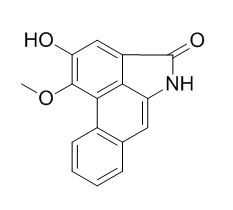Aristolactam AII
Aristolactam AII has cytotoxic activity, it also shows platelet aggregation inhibitory activity.
Inquire / Order:
manager@chemfaces.com
Technical Inquiries:
service@chemfaces.com
Tel:
+86-27-84237783
Fax:
+86-27-84254680
Address:
1 Building, No. 83, CheCheng Rd., Wuhan Economic and Technological Development Zone, Wuhan, Hubei 430056, PRC
Providing storage is as stated on the product vial and the vial is kept tightly sealed, the product can be stored for up to
24 months(2-8C).
Wherever possible, you should prepare and use solutions on the same day. However, if you need to make up stock solutions in advance, we recommend that you store the solution as aliquots in tightly sealed vials at -20C. Generally, these will be useable for up to two weeks. Before use, and prior to opening the vial we recommend that you allow your product to equilibrate to room temperature for at least 1 hour.
Need more advice on solubility, usage and handling? Please email to: service@chemfaces.com
The packaging of the product may have turned upside down during transportation, resulting in the natural compounds adhering to the neck or cap of the vial. take the vial out of its packaging and gently shake to let the compounds fall to the bottom of the vial. for liquid products, centrifuge at 200-500 RPM to gather the liquid at the bottom of the vial. try to avoid loss or contamination during handling.
Int J Mol Sci.2019, 20(3):E651
J of Engineering Science&Technology2018, 13(9):2820-2828
J Bone Miner Res.2017, 32(12):2415-2430
J Appl Biol Chem.2024, 67:47,337-343.
Phytomedicine.2022, 100:154085.
Sci Rep.2021, 11(1):10931.
FARMACIA2023, Vol.71,3.
Sci Rep. 2018, 462(8)
Biology (Basel).2020, 9(11):363.
Front Nutr.2024, 11:1409309.
Related and Featured Products
Phytochemistry. 2013 Feb;86:121-6.
Pyridocoumarin, aristolactam and aporphine alkaloids from the Australian rainforest plant Goniothalamus australis.[Pubmed:
23158725]
METHODS AND RESULTS:
Chemical investigation of the CH(2)Cl(2)/CH(3)OH extracts from aerial parts of the Australian plant Goniothalamus australis has resulted in the isolation of two pyridocoumarin alkaloids, goniothalines A (1) and B (2) as well as eight known natural products,
Aristolactam AII (3), enterocarpam II (4), caldensine (5), sauristolactam (6), (-)-anonaine (7), asimilobine (8), altholactone (9) and ( )-goniofufurone (10). The chemical structures of all compounds were determined by extensive spectroscopic and spectrometric analysis. Methylation of 2 using TMS-diazomethane afforded 1, which unequivocally established that both 1 and 2 possessed a 10-methyl-2H-pyrano[2,3-f]quinolin-2-one skeleton. These pyridocoumarin alkaloids are putatively proposed to arise biosynthetically from an aporphinoid precursor. Compounds 1-10 were evaluated for in vitro antimalarial activity against a chloroquine-sensitive Plasmodium falciparum line (3D7).
CONCLUSIONS:
Sauristolactam (6) and (-)-anonaine (7) exhibited the most potent antiparasitic activity with IC(50) values of 9 and 7 μM, respectively.



